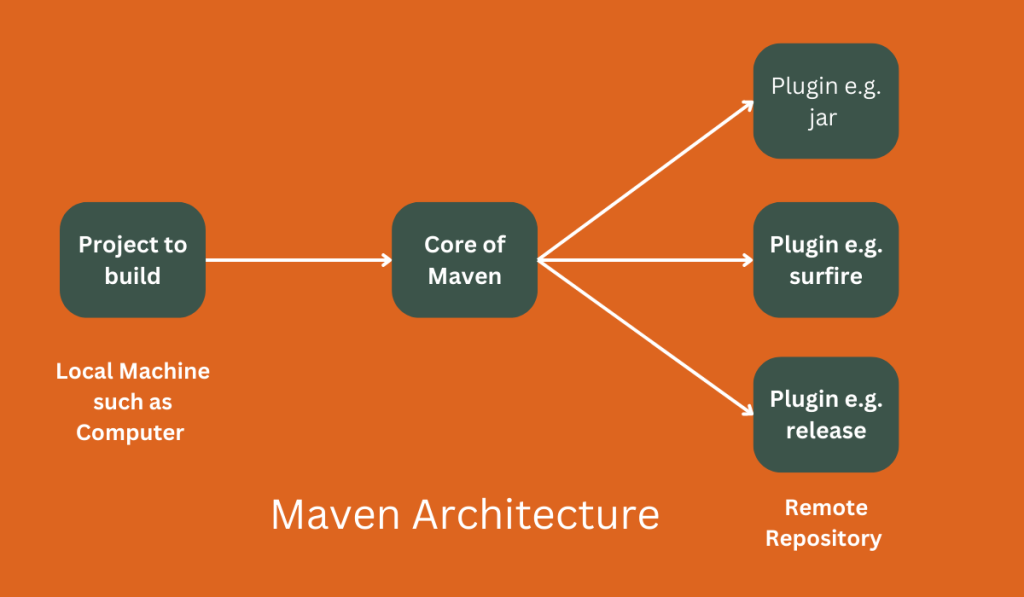In the field of software development, productivity and planning are essential. One of the many things developers juggle is managing dependencies, along with making sure builds and deployments go smoothly. It’s where Maven enters the picture. Mostly used for Java projects, Maven is a robust build automation tool that may also be used with other programming languages. This blog delves into the definition, applications, and architecture of Maven.
What is Maven?
A project management and comprehension tool, Maven is a component of the Apache Software Foundation and offers a complete framework for creating, overseeing, and comprehending software projects. It provides a consistent build system and streamlines the build process, which helps developers manage the complexity of projects.

Key Features:
- Dependency Management: Gathers the required libraries from central sources and manages dependencies for projects automatically.
- Build automation: Makes building faster and more repeatable by streamlining the build procedure.
- Project management: Using a project object model (POM) and a defined directory layout, it makes project setup easier.
- Flexible: Allows for the addition of plugins to increase its capabilities for a variety of activities, such as code compilation, test execution, and report generation.
Uses of Maven
- Standardization: Teams can adhere to a defined project structure by using Maven, which makes it simpler for new engineers to comprehend and participate in the project. Additionally, the integration of new tools and technologies is made easier by this standardization.
- Build and Deployment: Maven streamlines the compilation, testing, and packaging of projects by automating the build process. Additionally, it facilitates procedures for continuous integration and continuous deployment (CI/CD), which improves the effectiveness of the development pipeline.
- Project Documentation: Maven is capable of producing thorough project documentation, which includes dependency analysis, test coverage, and code quality reports. This promotes the upkeep of strict guidelines for project transparency and code quality.
- Multi-Module Projects: Maven facilitates the management of projects with several modules, enabling developers to divide larger projects into more manageable, smaller modules. Maintainability and scalability are enhanced by this modular approach.
- Dependency Management: Maven manages the dependencies required for a project. It automatically downloads and updates libraries and plugins from central repositories, ensuring that all dependencies are up to date and correctly configured.
Architecture of Maven
Maven’s architecture is designed to facilitate efficient project management and build processes. Understanding its architecture helps in leveraging its full potential.

Core Components:
- Project Object Model (POM):
- POM.xml: In Maven, the POM is the basic unit of work. It’s an XML file with project data and configuration information that Maven uses to construct the project. It contains the build parameters, plugin configurations, and dependencies for the project.
- Repository:
- Local Repository: A developer’s local machine cache where Maven stores downloaded artifacts (libraries, plugins, etc.).
- Central Repository: An extensive collection of artifacts housed in a remote repository made available via Maven. If required dependencies are not accessible locally, Maven obtains them from this repository.
- Remote Repositories: Additional repositories can be specified in the POM for accessing specific dependencies not available in the central repository.
- Build Lifecycle:
- Phases: Validate, compile, test, package, verify, install, and deploy are some of the phases that make up the typical build lifecycle that Maven defines. Every phase denotes a certain stage of the building process.
- Goals: Objectives are the particular actions carried out in each stage. For instance, compiling the project’s source code is a part of the compile step.
- Plugins:
- Plugins increase Maven’s built-in capabilities. They are employed for certain functions such code compilation, testing, application packaging, and documentation production. The build process may be made extremely configurable and extensible thanks to Maven’s plugin-based design.
Maven Workflow:
- Initialization: Maven initializes the project setup by reading the POM.xml file.
- Dependency Resolution: Maven gets and resolves dependencies for the project from the repositories.
- Build Execution: Maven applies the goals defined for each phase of the build lifecycle, executing the phases in order.
- Output Generation: Build outputs, including compiled code, test reports, and packaged artifacts, are produced by Maven.
Conclusion
Maven is a powerful and adaptable project management solution that makes software development less complicated. It is a priceless tool for developers because of its capacity to automate builds, manage dependencies, standardize project structures, and enable multi-module projects. Development teams can ensure effective project management, maintain high code quality, and increase productivity by comprehending its architecture and utilizing its potent features. Knowing how to use Maven effectively will greatly improve your development workflow and help your projects succeed, regardless of experience level.
